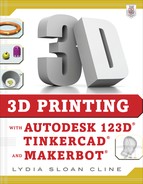Preface
THE PAST 10 YEARS have seen an explosion of interest and potential in 3D printing. Novices and professionals are using it to make their lives and jobs more rewarding and productive. When this technology is combined with websites such as Quirky, Kickstarter, Indiegogo, Prosper, Etsy, Shapeways, Ponoko, and Facebook, people are empowered to turn hobbies into businesses, start side businesses, and leave jobs they no longer like or that have left them. 3D printing is truly a part of the New Industrial Revolution.
Thought leaders compare current 3D printers to the dot-matrix printers and the Apple Macintosh of the early 1980s. Being competitive will eventually require knowledge of this technology because it will surely disrupt and innovate in diverse fields. Electronics, toy, food, and automotive companies are experimenting with it, as is the construction industry and the military. 3D printing solutions are being considered as answers to substandard housing in developing countries and in other applications we can barely imagine right now.
Creating, manufacturing, and advertising is becoming democratized due to affordable tools and low start-up costs. No matter what your age or background is, you can participate; the barriers are low. The same way that software and laser printers let anyone publish from their kitchen table, and WordPress and websites let anyone open a nice storefront, now anyone with knowledge of 3D software and printing technology can put out a product. Although no one foresees an end to mass manufacturing, it’s a good bet that micro-manufacturing and just-in-time manufacturing catering to niche and customization markets will get bigger (see Figure 1). One size no longer fits all.

Figure 1 At www.makie.me, customers can select features for dolls, which are then 3D-printed and shipped to them. These dolls were displayed at Autodesk University.
Websites such as Thingiverse and Instructables, where designs are freely shared, let the world tinker with, customize, and improve each other’s work in the spirit of open source. Maker Faires let them show off what they’ve done.
The MakerBot company has crowd-sourced an effort to get a 3D printer in every classroom. Making may (and should) eventually be part of the curriculum. The nascent Maker Movement might counter cheap overseas labor and bring manufacturing back to the U.S. 3D printing is for teachers, students, homeschoolers, dreamers, entrepreneurs, and the merely curious—and because you’re holding this book, you’re obviously interested in it! You may already have some concrete ideas about what you’d like to do. So, congratulations in finding your way here, because now you’ll learn how to turn those ideas into a physical product.
Let’s get started.
